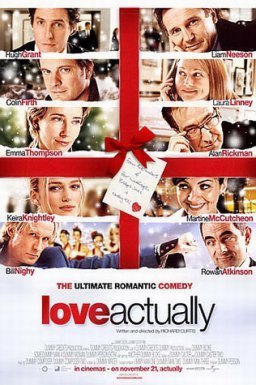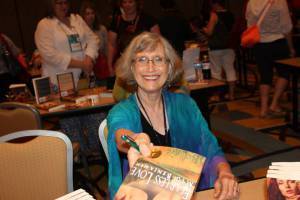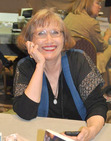Meg Benjamin's Blog, page 11
January 2, 2014
Love, Sort Of
 So this is the tenth anniversary of Love, Actually, the British ensemble film that’s become a Christmas staple for a lot of us. I’ll go on record here as being a fan—I find the film funny and touching and ultimately charming. I’d much rather watch it than a lot of Christmas movies (::cough:: Miracle On 34th Street ::cough::). But as is the way with cultural phenomena, when a lot of people like something, you’ll eventually start getting pushback. Christopher Orr slammed Love Actually in the Atlantic. Lindy West went after it with a metaphorical hatchet in Jezebel. Other people weighed in with negative comments.
So this is the tenth anniversary of Love, Actually, the British ensemble film that’s become a Christmas staple for a lot of us. I’ll go on record here as being a fan—I find the film funny and touching and ultimately charming. I’d much rather watch it than a lot of Christmas movies (::cough:: Miracle On 34th Street ::cough::). But as is the way with cultural phenomena, when a lot of people like something, you’ll eventually start getting pushback. Christopher Orr slammed Love Actually in the Atlantic. Lindy West went after it with a metaphorical hatchet in Jezebel. Other people weighed in with negative comments.
The thrust of all these bad reviews is basically that Love, Actually is over-rated romantic tripe, and that people who like it are sentimental dummies. For those of us who occasionally fall for romantic comedies, these are familiar arguments—most romantic comedies get hit with nasty reactions at some point. But it seems to me this argument misses the point. It’s not a question of whether Love, Actually is good or bad. The question is why a critic feels called upon to go after people for liking something he/she doesn’t.
Criticism serves a purpose—a good critic can illuminate why something works or doesn’t work. But there’s something about this ex post facto criticism that grates. In a sense these critics aren’t so much analyzing the movie itself as they’re analyzing and dismissing the people who happen to like the movie. It reminds me of something William Goldman once said—snobby people can never really like anything because they’re afraid some even more snobby people will say, “Oh, so that’s the kind of thing you like.” In effect these critics are sneering at the movie’s fans: “How can you like something so puerile? Allow me to kick it to pieces to show you how mistaken you are in your bad taste.”
It isn’t just Love, Actually that gets hit by this kind of reaction. Pick a movie you like and do a quick search. You’ll usually find somebody who’s quite willing to tell you it sucks. Love Casablanca? Silly you. Some Like It Hot? Nope. Pauline Kael, that doyenne of movie critics, seemed to specialize in this kind of movie fan bashing at times, as witness her dismissal of the wildly popular Butch Cassidy and the Sundance Kid.
Love, Actually has a lot of admirers too, but it also has a lot of people who don’t like it. The important question is So What? So what if you don’t like a movie? Why should that mean you need to go after those who do? If you think you can convince them to dislike the movie, let me assure you that’s not going to happen. The idea that you can somehow persuade someone to dislike something they admire or like something they hate by giving them your own detailed hatchet job is sort of ludicrous.
Believe it or not, I don’t much like The Sound of Music, and I’m willing to bet I’m not alone in that opinion. Does that make The Sound of Music a bad movie? Nope. It just makes it a movie I don’t like very much. You are within your rights to like or dislike anything. But that doesn’t mean you get to make that decision for everybody else, or to make fun of those who don’t share your opinion. That’s not being a critic, that’s being a crank. And Lord knows we already have more than enough of those!
So if you haven’t seen Love, Actually, I invite you to check it out. And make up your own mind. It really doesn’t matter which critics like it and dislike it. What matters is your opinion. In the end, in fact, when it comes to choosing what film to see, that’s all that really does matter.


December 24, 2013
Christmas Greetings!
December 18, 2013
Chickens, Why Did It Have To Be Chickens?
 Fearless Love, my seventh Konigsburg book, is now available in print from the usual outlets.
Fearless Love, my seventh Konigsburg book, is now available in print from the usual outlets.
All of my Konigsburg books include animals. I’m not sure how this happened, it just did. Starting with a diabolic cat and a sweet-natured Chihuahua in Venus In Blue Jeans, I had a greyhound in Wedding Bell Blues, a mostly coon hound puppy in Be My Baby, a largely Maine coon cat in Long Time Gone and Don’t Forget Me, and an iguana named Doris in Brand New Me.
When I got to Fearless Love, the choice was already clear, and so, as it turned out, was the animal. Chickens. My heroine, MG Carmody, inherits a chicken farm from her grandfather. MG doesn’t have much else she can depend on in the way of income—she’s a struggling singer trying to regain her confidence after some bad experiences in Nashville. So she decides to sell eggs. And I had to find out how you raise chickens.
Fortunately for me, Denver (where I live now) had just passed an ordinance allowing urban farmers to raise a few chickens in their backyards. All of a sudden chickens were in the news, and it turned out I actually knew a few people who were raising them. Plus Denver wasn’t the only city in the country where people had decided that having backyard chickens was a good idea. I found Web sites galore with loads of chicken information.
So what did I learn? All sorts of stuff. Hens usually lay only one egg a day and they may not come through every time (so my heroine’s twenty-five chickens wouldn’t necessarily produce twenty-five eggs). They don’t lay while they’re molting, and they stop laying altogether when they age (two to three years). This creates all kinds of dilemmas for the soft-hearted urban chicken farmers who can’t bring themselves to do what traditional farmers do with aging hens—make chicken soup. I also found out raising chickens is a lot of work, which fit in with my story. Between her job in a restaurant kitchen, her reborn music career and her chickens, MG is frequently exhausted.
Although most of the chicken authorities cautioned against naming your birds (you don’t want to get too attached), I decided that I’d have at least one chicken with attitude, a rooster named Robespierre. He has a run-in with a coyote and the result is based on a similar story I picked up from a chicken blogger (yes, Virginia, there are chicken bloggers).
MG finally triumphs, with the help of my hero, Joe LeBlanc, a chef who turns out to know a lot about chickens himself. And I’ve now got enough information about chickens to know for sure that I’m not going to be raising them myself any time soon!
Here’s the blurb for Fearless Love:
Fearless Love, Konigsberg, Texas, Book 7
Sweet music doesn’t come without a few sour notes.
MG Carmody never figured her musical dreams would crash against the reality of Nashville. Now the only thing she has going for her is her late grandfather’s chicken farm, which comes with molting hens that won’t lay, one irascible rooster, and a huge mortgage held by a ruthless opponent—her Great Aunt Nedda.
With fewer eggs to sell, MG needs extra money, fast. Even if it means carving out time for a job as a prep cook at The Rose—and resisting her attraction to its sexy head chef.
Joe LeBlanc has problems of his own. He’s got a kitchen full of temperamental cooks—one of whom is a sneak thief—a demanding cooking competition to prepare for, and an attraction to MG that could easily boil over into something tasty. If he could figure out the cause of the shy beauty’s lack of self confidence.
In Joe’s arms, MG’s heart begins to find its voice. But between kitchen thieves, performance anxiety, saucy saboteurs, greedy relatives, and one very pissed-off rooster, the chances of them ever making sweet music are looking slimmer by the day.
Warning: Contains hot kitchen sex, cool Americana music, foodie hysteria, and a whole lot of fowl play.
Buy link: http://store.samhainpublishing.com/fearless-love-p-7011.html


December 4, 2013
My Secret Identity

Photo by PJ Ausdenmore
Okay, I admit it—one of the things I love to do whenever we go traveling is shop. More specifically, I love to shop for things like lacy tops, silk ruanas, or vests made from vintage kimonos. I’m a sucker for anything funky and slightly romantic, which a lot of vacation spots have in abundance.
But every once in a while, I’ll see a sales lady watching me with a particular expression I know well. And I know exactly what she’s thinking: Honey, you’ll never wear that. Because, of course, she’s seeing the everyday me. The slightly older, slightly heavier, slightly bland woman who looks like everybody’s Aunt Margie. And it’s quite true that Aunt Margie would probably never wear that lace overblouse, although it might hang in her closet for decades.
But here’s the thing—I’m only Aunt Margie most of the year. Believe it or not, toots, I also have a secret identity.
Two or three times a year, I get to wear those imaginative duds among crowds of other women who are a lot like me. We all save our most fanciful clothes for those times when we’re sitting behind tables at RT or RWA, signing our books and smiling at all and sundry. A few times a year I morph into Romance Writer, and I love doing it.
So let this be a cautionary tale for all those oh-so-superior sales ladies who are convinced that older women never get to wear cool clothes and that we might as well confine ourselves to knit pantsuits the way we’re supposed to. You never know what magic lurks within each of us. Maybe we’re actually somebody else part of the time. And maybe getting a chance to wear those wonderful things at writers conferences has emboldened us to wear our secret identities at other events as well. Maybe we sometimes break out that sequined jacket for Sunday services. Maybe that hand-painted ruana will be perfect for our niece’s commencement ceremonies. And maybe that purple velvet cape will see service at next year’s Christmas party.
You never know.
So let us buy what we want, and save the stink eye. You really never know—someday you too may be looking at those knee-high suede boots and thinking, “Yeah, I could do that at Authors After Dark. No problem.”
That is, of course, if you’re lucky enough to have a secret identity of your own. And this being the holiday season, in which rancor is out of place, I’ll wish that for you. May we all have secret identities we get to dress up for. At least once or twice a year.


November 25, 2013
The Wicked Oppressing, Pray Keep Them From This Dressing
 If you’ve sung “The Thanksgiving Hymn” (aka “We Gather Together”), you may recognize my title. The actual line, of course, is “The wicked oppressing, pray cease from distressing”, but when I was a kid, I heard it the other way. I really liked dressing, you see, and keeping the wicked away from it struck me as a fitting punishment.
If you’ve sung “The Thanksgiving Hymn” (aka “We Gather Together”), you may recognize my title. The actual line, of course, is “The wicked oppressing, pray cease from distressing”, but when I was a kid, I heard it the other way. I really liked dressing, you see, and keeping the wicked away from it struck me as a fitting punishment.
So this is a post about dressing. Not stuffing, mind you. Other people might stuff their turkeys, but we of the Weathers clan had only dressing baked separately in a glass casserole dish. That was one of the guiding dressing principles, but not the only one. Here then are The Dressing Rules as passed down from my forefathers, or more likely foremothers. I don’t necessarily obey them all, but I have to admit I’m still aware of them.
Proper dressing is austere, even minimalist. No eggs, no sausage, certainly nothing like chestnuts or oysters. I suspect this was partly due to the fact that we lived in Wichita, Kansas, where additions like chestnuts and oysters were not particularly easy to come by. Anyway, dressing as I know it includes only celery and onions along with the bread. As I recall, my mom would toss that chopped up onion and celery into the dressing raw to cook in the oven along with the turkey. I break with tradition and sauté the veggies in butter. Lots of it.
About the bread. True dressing is made with stale bread you’ve been saving for that purpose. Thus it includes lots of heels and little thin pieces that nobody wants for a sandwich. This in turn means that there are some fairly recalcitrant pieces of bread in the dressing that never really soften up. This is another rule I disobey. Stale bread tastes like, well, stale bread. I make a couple of pans of cornbread using a mix (yeah, usually Jiffy) and let it sit out overnight to get a bit more substantial than it is straight out of the oven. If I’m feeling particularly fancy, I may buy a baguette, cut it into pieces, and let it sit out too. Needless to say, the Wichita of my youth had no baguettes available.
When you put everything together (i.e., bread, onions, and celery), you soften the mixture with liquid, and here again I have major differences with The Dressing Rules. My mom, for reasons that escape me, dunked the bread in ice water and then rung it dry, creating a damp but crummy mixture. I use warm stock, usually vegetable stock since our Thanksgiving guests include vegetarians. I also don’t wring it out since a wet mixture seems to puff up better than a dry one.
On seasonings, I’m a purist. Salt, pepper, and powdered sage. I may occasionally throw in a little thyme if it’s available. But since I’m usually cooking in an unfamiliar kitchen, I stay with the big three.
And then you bake it. Oven temperature doesn’t matter much—anywhere from 325 to 375 seems to work. Length of baking time depends on how hot the oven is. Just follow the old recipe guideline “’Til it be enough.”
And it will be good. Very good. Good enough that you will definitely want to keep the wicked as far away from it as possible.
Happy Thanksgiving, y’all!


November 20, 2013
Cooking Thoughts: Cooking High
 I live at altitude—around 5600 feet, to be exact. Altitude has a lot of effects, including thinner air, brighter sunshine, and (apparently) a greater tendency toward suicide. However, one area of life where altitude has a very pronounced effect is cooking. Atmospheric pressure decreases as altitude increases, and that fact turns out to screw with some of the most basic aspects of food prep.
I live at altitude—around 5600 feet, to be exact. Altitude has a lot of effects, including thinner air, brighter sunshine, and (apparently) a greater tendency toward suicide. However, one area of life where altitude has a very pronounced effect is cooking. Atmospheric pressure decreases as altitude increases, and that fact turns out to screw with some of the most basic aspects of food prep.
There is, for example, the fact that almost every bag of food you buy at the grocery store is inflated, so that a bag of, say, Doritos looks sort of like a Doritos balloon. This inflation is the result of transporting sealed goods manufactured at lower altitudes to higher altitudes. The lower atmospheric pressure outside the bag allows the air in the bag to expand. The balloon effect doesn’t hurt the food, of course, and I like to think it even provides a little extra protection for your potato chips, but it’s unsettling to say the least.
I’m not a baker, so some of the most notorious altitude effects don’t get to me, but baking around here requires adjustments in both ingredients and cooking time. The decreased atmospheric pressure means that your breads and cakes can rise higher, which, in turn, means that they’ll collapse unless there’s extra flour to provide more structure. The combination of altitude and very low humidity can also doom your cookies, particularly delicate ones.
The altitude effect that hits me most directly, however, is the simple fact that lower atmospheric pressure means that water boils at a lower temperature. So what, you say? Try boiling spaghetti for the same length of time you do in, say, San Antonio, and you’ll have spaghetti that’s very, very al dente. Pasta actually isn’t a problem, although the increased cooking time can be an annoyance—you can just fish a strand of spaghetti out of the boiling water and taste it to see if the stuff is cooked enough. No, the real problem comes with something like rice or beans. You end up cooking rice like spaghetti: in a large pot of boiling water. Cook the rice that way and it will end up soft, although you’ll still have to cook if for longer than you’re used to. Cook the rice the low altitude way—carefully measuring water and letting the rice absorb the moisture—and you’ll probably end up with the same very, very al dente rice.
And then there are beans. I think the thing that finally drove me over the edge with bean cookery was when I tried making black bean soup in my slow cooker. I soaked the beans overnight and then cooked them for eight hours in the slow cooker, the smell of long-cooked bean soup driving me slowly mad with hunger. Then I served up a couple of bowls for the hubs and myself. And bit into beans that were very, very al dente.
I bought a pressure cooker then because I’d heard Jacques Pepin (whose daughter Claudine lives in Denver) argue that it was the only way to cook beans at altitude. It works, although I’m still learning how to calibrate the thing. The recipe booklet that came with the cooker said to cook beans between five and ten minutes. Nope. Lorna Sass, bless her, has more precise cooking times between twenty and thirty minutes. But even at that length I’ve had mixed success. I’m learning that dried beans differ in their age and that older beans will take much longer to cook. Since I buy a lot of heirloom beans at farmers markets, I can end up with some beans that are overcooked and some that are, once again, very, very al dente.
So cooking at altitude is a challenge. But it’s an interesting challenge. And I’ve come to think of it as part of the whole Colorado gestalt. Outdoor markets, dried beans, and long-boiling pots—we may not be mountain men, but there are times when I think we’re close!


November 13, 2013
The Giving Tree and Me
 Eloisa James recently quoted the final lines of Shel Silverstein’s The Giving Tree on Facebook. She described it as “a book that needs no introduction.” She’s probably right—I’m sure the majority of people who saw those lines recognized them immediately. I’ve heard The Giving Tree quoted in sermons. I’ve seen adults tear up as they reach they end. I’ve seen adults tear up as they refer to the end. Everybody loves The Giving Tree.
Eloisa James recently quoted the final lines of Shel Silverstein’s The Giving Tree on Facebook. She described it as “a book that needs no introduction.” She’s probably right—I’m sure the majority of people who saw those lines recognized them immediately. I’ve heard The Giving Tree quoted in sermons. I’ve seen adults tear up as they reach they end. I’ve seen adults tear up as they refer to the end. Everybody loves The Giving Tree.
Everybody but me.
If you’ve never heard of the book, you may need a quick recap. The Giving Tree is a children’s picture book about the relationship between a boy and a tree. The tree gives the boy everything she can (and yes, it’s a she—Silverstein uses that pronoun specifically). When he’s a child, the boy swings from her branches, rests in her shade, and eats her apples. But as the boy grows older, his demands grow too. When he needs money, he sells her apples (at her suggestion). When he needs a house, he takes her branches to build it. When he needs a boat, he takes her trunk to make it. The tree is perfectly okay with all of this, of course. In fact, she suggests most of it herself. But the boy/man is never entirely satisfied. At the end of the book, he returns, a shriveled old man, and sits down to rest, leaning on the stump that’s all that’s left of the tree. And the final words of the book? “And the tree was happy.”
There are a lot of interpretations of this book, some of them religious (the tree is God) or environmentalist (the tree is Mother Nature). But the interpretation I’ve seen most frequently is that the tree and the boy represent parent and child. More specifically the tree is Mom, constantly giving whatever she has to her children until there’s basically nothing left. But she’s happy because, as Mom, that’s what she’s supposed to do.
And that, my friends, is why I find this book sort of disturbing. Because, no, that’s not what Mom is supposed to do. Mom or Dad either one. What Mom and Dad are really supposed to do is raise a kid who’s not a selfish little snot. Moreover, there’s something troubling about a book that hypothesizes the parent/child relationship in a way that makes the child a kind of emotional vampire and the parents a pair of chumps. There is nothing particularly noble about parents as enablers.
As a point of contrast, consider E. B. White’s Charlotte’s Web, another book in which the two protagonists (Charlotte and Wilbur) have a parent/child relationship. Charlotte also gives herself to Wilbur, devoting herself to keeping him alive. But in the end, when Charlotte dies, it isn’t because Wilbur has used her up. It’s because Charlotte has reached the end of her life cycle. And she doesn’t leave behind a selfish little pig (literally) who’s learned nothing. She leaves behind a pig who’s now able to stand on his own four feet. I feel annoyed with myself if I tear up over The Giving Tree, but the tears at the end of Charlotte’s Web are totally earned.
So if you want a children’s book that teaches the value of giving and receiving, I’d leave The Giving Tree on the shelf. But Charlotte’s Web? That’s a keeper.


November 6, 2013
Style and Substance
 So I picked up this book at my local library last week. I admit I was attracted by the cover to begin with, but the blurb sounded interesting. Plus I’d heard of the author—she’s fairly well known in her genre. I hoped I might discover an author I hadn’t read before with a sizeable backlist, always an enjoyable experience!
So I picked up this book at my local library last week. I admit I was attracted by the cover to begin with, but the blurb sounded interesting. Plus I’d heard of the author—she’s fairly well known in her genre. I hoped I might discover an author I hadn’t read before with a sizeable backlist, always an enjoyable experience!
But here’s the thing: the story that had attracted my attention via the blurb was good. The author had an interesting idea and she carried it through. But the writing? Not so much. What I had stumbled into was a standard conundrum—which matters more, the writing or the plot?
Now let me be clear here. This was a book published by a major house so it had obviously been copyedited. There were no grammatical or spelling errors of the type found in self-pubbed books whose authors haven’t bothered to spring for an editor. But the style was sort of, well, pedestrian. The characters never really came to life. The author told me what they were feeling, but I didn’t feel for them myself. The potentially intriguing villain stayed very much at arm’s length—I was told how clever she was, but nothing she did seemed to bear that out.
I kept reading, mainly because I wanted to see how the story played out, but I never really got into the book. And I skipped some sections, which is always a bad sign. I might read another book by this author, just to see if the style here was an anomaly, but it would have to be from the library. I won’t buy her books for myself.
There’s a maxim in the pop fiction game: good writing won’t save a bad story. To some extent I believe this, but I have to say I haven’t come across the good writing/bad story combination all that often. To me, the opposite should also be considered true: bad writing can sink a good story. In fact, I find that an author’s style is more likely to catch my attention than a sensational story, particularly if that story is too complex or convoluted. An elegant, engaging style will keep me going even when I can anticipate the twists and turns of the narrative. The pleasure of spending time with a skillful writer can mitigate the minor irritations of a predictable plot.
But, of course, it’s when plot and style combine to produce something out of the ordinary that real magic happens. My favorite authors—Loretta Chase, Jennifer Crusie, Sherry Thomas, etc.—are the ones who are skillful on both sides of the writing divide. When you find a book like that, you’ve hit the jackpot as a reader. And as writers, we’re all doing our best to create them.
So plot versus style? Why do we have to make a choice? As Guy Clark sings (in a totally different context), “Long as you’re handin’ it out, Lord, I’ll have a little of both.”


October 30, 2013
Tess Gerritsen: Bringing the Scary
 I’m the author of three ghost romances (Medium Well, Medium Rare, and Happy Medium, thanks for asking), so I know something about scariness. But this post isn’t about my books—I’ve already posted quite a bit about them, like this, this, and this. This post is about Tess Gerritsen’s books, which are some of the scariest I know.
I’m the author of three ghost romances (Medium Well, Medium Rare, and Happy Medium, thanks for asking), so I know something about scariness. But this post isn’t about my books—I’ve already posted quite a bit about them, like this, this, and this. This post is about Tess Gerritsen’s books, which are some of the scariest I know.
However, Gerrtisen’s stuff rarely gets cited for its scare quotient at this time of year, perhaps largely because she writes thrillers rather than paranormal novels. Still, page for page, I find her books a lot more creepy than, say, the average vampire story. Gerritsen’s villains are serial killers, but they’re frequently serial killers with a twist. There’s the murderer in The Keepsake who’s obsessed with ancient methods of preserving the dead. And the murderer in The Mephisto Club who uses bits and snatches from the Apocrypha to give his crimes a particularly shuddery twist. And the murderer in Last To Die who wipes out entire families.
Along with the murderers, Gerritsen presents potential victims, sometimes writing parts of the story in first person to reflect their points of view. These victims most frequently know who’s after them but for complicated reasons they resist turning to the police for help. They also become Gerritsen’s major conveyors of dread—they know just how terrible the fate is that could await them and they’re doing their best to avoid it.
For a long time I tried to avoid it too. I read a couple of Gerritsen’s books (The Apprentice was one of them as I recall), and I found myself placing her in the same category as Law and Order: SVU and Criminal Minds, shows I dislike intensely because of their obsession with the victimization of women. There’s something deeply disturbing about women’s suffering and terror being held up for display, both on television and in books, and since Gerritsen’s victims are almost entirely female she might seem to fit into that category.
But when I went back and read a couple of her other books (Silent Girl and Last To Die, for the record), I began to see other dimensions to her work that hadn’t really registered before. First, the murderers frequently target women, but the women they target aren’t necessarily helpless. They may be on the run, but they know what needs to be done and they do it. In other words, they don’t simply surrender to terror or sit and wait to be rescued. They fight. And then the murderers usually do, in fact, have motivation for their murders. That motivation may be twisted in the extreme, but they don’t just kill for fun.
Gerritsen has two female heroines, Maura Isles and Jane Rizzoli,* and these two are the ones most likely to confront the Big Bad, but the victim Gerritsen focuses on confronts him too, and lives to tell the tale.
There are whiffs of the supernatural in Gerritsen. Her killers are so diabolical that they frequently seem to be from another species, and there’s a continuing plot about a group of demon hunters, The Mephisto Foundation, that actually believes that’s true. But neither Rizzoli nor Isles agrees with them. The Mephistos are simply presented as an alternative explanation.
It’s not exactly female empowerment, but I’d argue it’s a form of subversion. You come out of a Gerritsen novel shaken up by the evil that the characters encounter, but also reassured that they can triumph over it, and triumph through human means. So you get both the scary and the resolution of the scary. And isn’t that sort of what Halloween is all about?
*Yeah, Gerritsen’s novels are the basis for the Rizzoli and Isles television series, but the novels and the series are as different as, well, night and day. The novels are dark and moody. The series isn’t. Even if you don’t much like Rizzoli and Isles (and I don’t), you may like Gerritsen’s books (and I do).


October 23, 2013
Making Your Own Reunion
 I’m not much for reunions. I’ve never made it to my college reunions because they always seem to take place on my wedding anniversary (hubs and I tied the knot right after graduation) and rural Iowa is not exactly the ideal place to celebrate your wedding. I made it to one of my high school reunions and decided I didn’t need to go to any more. When the invitations went out for this year’s reunion, though, I contacted my best friend from high school to see if she wanted to go. She was enthusiastic about getting together, but equally lukewarm about heading off to Wichita, Kansas.
I’m not much for reunions. I’ve never made it to my college reunions because they always seem to take place on my wedding anniversary (hubs and I tied the knot right after graduation) and rural Iowa is not exactly the ideal place to celebrate your wedding. I made it to one of my high school reunions and decided I didn’t need to go to any more. When the invitations went out for this year’s reunion, though, I contacted my best friend from high school to see if she wanted to go. She was enthusiastic about getting together, but equally lukewarm about heading off to Wichita, Kansas.
Well, said I, does a high school reunion have to take place at high school?
Which explains how I ended up in San Diego last week. My friend Peg and I decided to have our own ad hoc high school reunion in a place that would be more fun to visit than Kansas in October. Peg’s from Arizona and I’m from Colorado, so California was fairly close for both of us (plus I prefer flying west to flying east—far more fun to gain an hour than to lose two). We ate a lot of sea food, drank a lot of wine (me) and martinis (Peg) and generally had a great time. So what did I learn?
1. “Hop on, hop off” trolley tours are the best. In a place like San Diego where there are lots of attractions spread out around the area, a trolley tour can save you a lot of time and let you take sight-seeing at your own pace (as long as you’re back on the trolley before five). Thanks to the tour, we got to see Coronado, Little Italy, and Old Town, as well as having a nice long trolley ride to let our feet recover from all that walking.
2. If you see a farmers market while you’re on vacation, by all means go. I’d already discovered this in the Western Colorado tour the hubs and I took last month, but I discovered it again in San Diego. California farmers markets are strange and wonderful from a Coloradoan point of view. Lots of olive oil. Far fewer custom meat purveyors (no Berkshire hogs—a staple of Colorado farmers markets). At least I couldn’t load up on produce this time, but I could sure admire it.
3. The Birch Aquarium at Scripps Institution of Oceanography is so worth a visit. They have leafy sea dragons. Leafy sea dragons. I would have stood next to the glass and watched them for hours if I hadn’t also been surrounded by shrieking toddlers. I got the T-shirt, though.
4. Balboa park is simply amazing—I know of no other city park like it. Museums, gardens, an outdoor organ amphitheater (we heard the organist practicing). The Mingei Museum is not to be missed. They had a chair exhibit, which sounds weird, I know, but which was actually sort of great. We spent an entire day in the park, but as we were leaving we were both noticing things we’d missed. Sometime I’ll walk down Palm Canyon, so help me.
And yes, we did drink a toast to Wichita High School East. Several of them, in fact. I can’t wait for my next high school reunion. I’m thinking Santa Barbara this time around!








